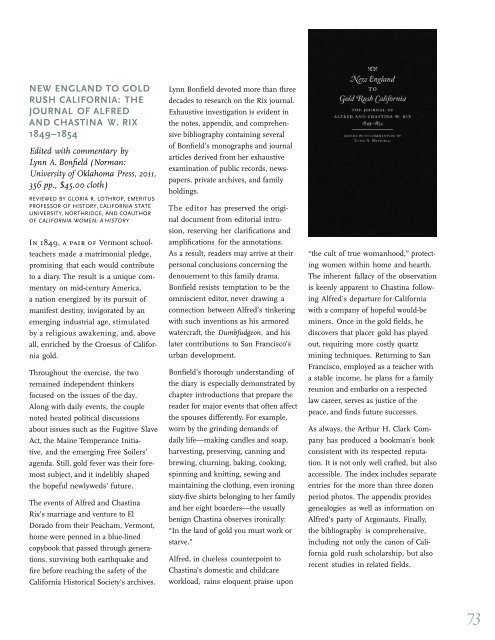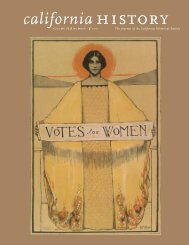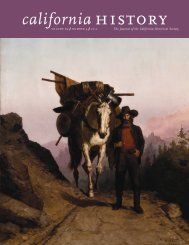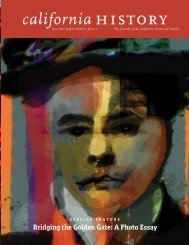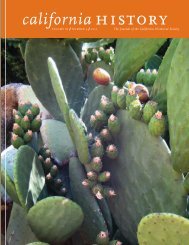Volume 90, Number 1 - California Historical Society
Volume 90, Number 1 - California Historical Society
Volume 90, Number 1 - California Historical Society
You also want an ePaper? Increase the reach of your titles
YUMPU automatically turns print PDFs into web optimized ePapers that Google loves.
neW england to gold<br />
rush california: the<br />
Journal of alfred<br />
and chastina W. rix<br />
1849–1854<br />
Edited with commentary by<br />
Lynn A. Bonfield (Norman:<br />
University of Oklahoma Press, 2011,<br />
356 pp., $45.00 cloth)<br />
REVIEWED BY GLORIA R . LOTHROP, EMERITUS<br />
PROFESSOR OF HISTORY, CALIFORNIA STATE<br />
UNIVERSITY, NORTHRIDGE, AND COAUTHOR<br />
OF CAlIfOrnIA WOmEn: A HISTOry<br />
In 1849, a pair of Vermont schoolteachers<br />
made a matrimonial pledge,<br />
promising that each would contribute<br />
to a diary. The result is a unique commentary<br />
on mid-century America,<br />
a nation energized by its pursuit of<br />
manifest destiny, invigorated by an<br />
emerging industrial age, stimulated<br />
by a religious awakening, and, above<br />
all, enriched by the Croesus of <strong>California</strong><br />
gold.<br />
Throughout the exercise, the two<br />
remained independent thinkers<br />
focused on the issues of the day.<br />
Along with daily events, the couple<br />
noted heated political discussions<br />
about issues such as the Fugitive Slave<br />
Act, the Maine Temperance Initiative,<br />
and the emerging Free Soilers’<br />
agenda. Still, gold fever was their foremost<br />
subject, and it indelibly shaped<br />
the hopeful newlyweds’ future.<br />
The events of Alfred and Chastina<br />
Rix’s marriage and venture to El<br />
Dorado from their Peacham, Vermont,<br />
home were penned in a blue-lined<br />
copybook that passed through generations,<br />
surviving both earthquake and<br />
fire before reaching the safety of the<br />
<strong>California</strong> <strong>Historical</strong> <strong>Society</strong>’s archives.<br />
Lynn Bonfield devoted more than three<br />
decades to research on the Rix journal.<br />
Exhaustive investigation is evident in<br />
the notes, appendix, and comprehensive<br />
bibliography containing several<br />
of Bonfield’s monographs and journal<br />
articles derived from her exhaustive<br />
examination of public records, newspapers,<br />
private archives, and family<br />
holdings.<br />
The editor has preserved the original<br />
document from editorial intrusion,<br />
reserving her clarifications and<br />
amplifications for the annotations.<br />
As a result, readers may arrive at their<br />
personal conclusions concerning the<br />
denouement to this family drama.<br />
Bonfield resists temptation to be the<br />
omniscient editor, never drawing a<br />
connection between Alfred’s tinkering<br />
with such inventions as his armored<br />
watercraft, the Dumbfudgeon, and his<br />
later contributions to San Francisco’s<br />
urban development.<br />
Bonfield’s thorough understanding of<br />
the diary is especially demonstrated by<br />
chapter introductions that prepare the<br />
reader for major events that often affect<br />
the spouses differently. For example,<br />
worn by the grinding demands of<br />
daily life—making candles and soap,<br />
harvesting, preserving, canning and<br />
brewing, churning, baking, cooking,<br />
spinning and knitting, sewing and<br />
maintaining the clothing, even ironing<br />
sixty-five shirts belonging to her family<br />
and her eight boarders—the usually<br />
benign Chastina observes ironically:<br />
“In the land of gold you must work or<br />
starve.”<br />
Alfred, in clueless counterpoint to<br />
Chastina’s domestic and childcare<br />
workload, rains eloquent praise upon<br />
“the cult of true womanhood,” protect-<br />
ing women within home and hearth.<br />
The inherent fallacy of the observation<br />
is keenly apparent to Chastina following<br />
Alfred’s departure for <strong>California</strong><br />
with a company of hopeful would-be<br />
miners. Once in the gold fields, he<br />
discovers that placer gold has played<br />
out, requiring more costly quartz<br />
mining techniques. Returning to San<br />
Francisco, employed as a teacher with<br />
a stable income, he plans for a family<br />
reunion and embarks on a respected<br />
law career, serves as justice of the<br />
peace, and finds future successes.<br />
As always, the Arthur H. Clark Company<br />
has produced a bookman’s book<br />
consistent with its respected reputation.<br />
It is not only well crafted, but also<br />
accessible. The index includes separate<br />
entries for the more than three dozen<br />
period photos. The appendix provides<br />
genealogies as well as information on<br />
Alfred’s party of Argonauts. Finally,<br />
the bibliography is comprehensive,<br />
including not only the canon of <strong>California</strong><br />
gold rush scholarship, but also<br />
recent studies in related fields.<br />
73


